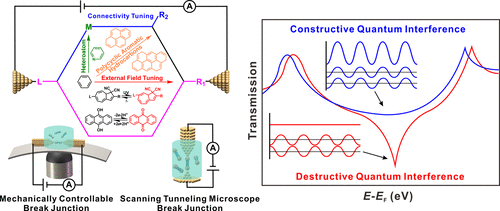当前位置:
X-MOL 学术
›
Acc. Chem. Res.
›
论文详情
Our official English website, www.x-mol.net, welcomes your
feedback! (Note: you will need to create a separate account there.)
Quantum Interference Effects in Charge Transport through Single-Molecule Junctions: Detection, Manipulation, and Application
Accounts of Chemical Research ( IF 16.4 ) Pub Date : 2018-11-30 00:00:00 , DOI: 10.1021/acs.accounts.8b00429 Junyang Liu 1 , Xiaoyan Huang 1 , Fei Wang 1 , Wenjing Hong 1
Accounts of Chemical Research ( IF 16.4 ) Pub Date : 2018-11-30 00:00:00 , DOI: 10.1021/acs.accounts.8b00429 Junyang Liu 1 , Xiaoyan Huang 1 , Fei Wang 1 , Wenjing Hong 1
Affiliation

|
Quantum interference effects (QIEs), which offer unique opportunities for the fine-tuning of charge transport through molecular building blocks by constructive or destructive quantum interference, have become an emerging area in single-molecule electronics. Benefiting from the QIEs, charge transport through molecular systems can be controlled through minor structural and environmental variations, which cause various charge transport states to be significantly changed from conductive to insulative states and offer promising applications in future functional single-molecule devices. Although QIEs were predicted by theoreticians more than two decades ago, only since 2011 have the challenges in ultralow conductance detection originating from destructive quantum interference been overcome experimentally. Currently, a series of single-molecule conductance investigations have been carried out experimentally to detect constructive and destructive QIEs in charge transport through various types of molecular junctions by altering molecular patterns and connectivities. Furthermore, the use of QIEs to tune the properties of charge transport through single-molecule junctions using external gating shows vital potential in future molecular electronic devices. The experimental and theoretical investigations of QIEs offer new fundamental understanding of the structural–electronic relationships in molecular devices and materials at the nanoscale.
中文翻译:

通过单分子结的电荷传输中的量子干扰效应:检测,操纵和应用
量子干扰效应(QIE)为单分子电子构造中的新兴领域提供了独特的机会,通过相长或相消量子干扰微调通过分子构件的电荷传输。受益于QIE,可以通过较小的结构和环境变化来控制分子系统中的电荷传输,这会导致各种电荷传输状态从导电状态显着改变为绝缘状态,并在未来的功能性单分子器件中提供了广阔的应用前景。尽管理论家们已经在20多年前对QIE进行了预测,但是直到2011年才通过实验克服了来自破坏性量子干扰的超低电导检测难题。目前,已经通过实验进行了一系列单分子电导研究,以通过改变分子模式和连接性来检测通过各种类型的分子结的电荷传输中的建设性和破坏性QIE。此外,使用QIE来调节使用外部门控通过单分子结的电荷传输的特性在未来的分子电子设备中显示出巨大的潜力。QIE的实验和理论研究为纳米级的分子器件和材料中的结构-电子关系提供了新的基本理解。QIE的使用,通过外部门控来调节通过单分子结的电荷传输的特性,在未来的分子电子设备中显示出巨大的潜力。QIE的实验和理论研究为纳米级的分子器件和材料中的结构-电子关系提供了新的基本理解。QIE的使用,通过外部门控来调节通过单分子结的电荷传输的特性,在未来的分子电子设备中显示出巨大的潜力。QIE的实验和理论研究为纳米级的分子器件和材料中的结构-电子关系提供了新的基本理解。
更新日期:2018-11-30
中文翻译:

通过单分子结的电荷传输中的量子干扰效应:检测,操纵和应用
量子干扰效应(QIE)为单分子电子构造中的新兴领域提供了独特的机会,通过相长或相消量子干扰微调通过分子构件的电荷传输。受益于QIE,可以通过较小的结构和环境变化来控制分子系统中的电荷传输,这会导致各种电荷传输状态从导电状态显着改变为绝缘状态,并在未来的功能性单分子器件中提供了广阔的应用前景。尽管理论家们已经在20多年前对QIE进行了预测,但是直到2011年才通过实验克服了来自破坏性量子干扰的超低电导检测难题。目前,已经通过实验进行了一系列单分子电导研究,以通过改变分子模式和连接性来检测通过各种类型的分子结的电荷传输中的建设性和破坏性QIE。此外,使用QIE来调节使用外部门控通过单分子结的电荷传输的特性在未来的分子电子设备中显示出巨大的潜力。QIE的实验和理论研究为纳米级的分子器件和材料中的结构-电子关系提供了新的基本理解。QIE的使用,通过外部门控来调节通过单分子结的电荷传输的特性,在未来的分子电子设备中显示出巨大的潜力。QIE的实验和理论研究为纳米级的分子器件和材料中的结构-电子关系提供了新的基本理解。QIE的使用,通过外部门控来调节通过单分子结的电荷传输的特性,在未来的分子电子设备中显示出巨大的潜力。QIE的实验和理论研究为纳米级的分子器件和材料中的结构-电子关系提供了新的基本理解。











































 京公网安备 11010802027423号
京公网安备 11010802027423号